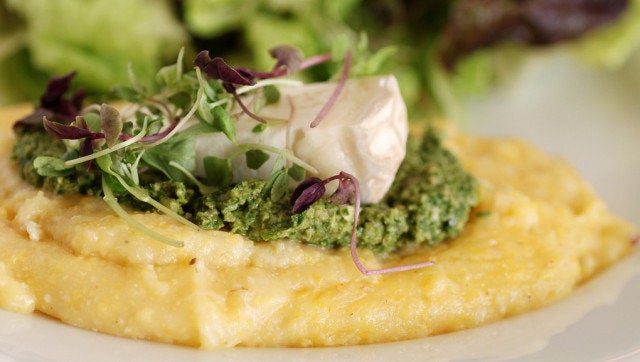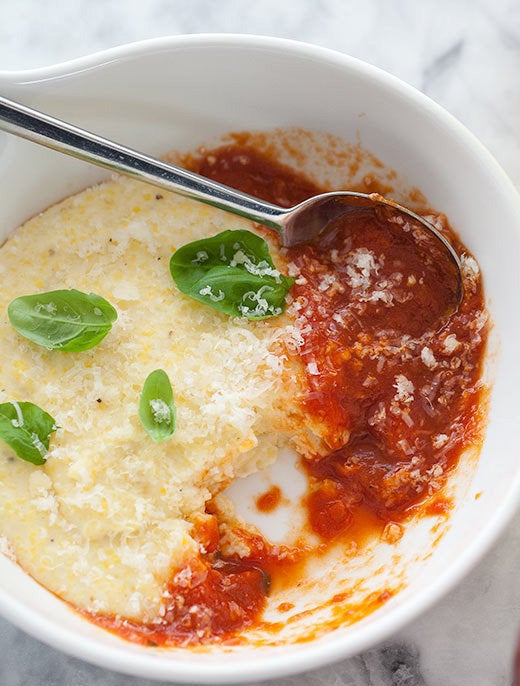
Sometimes we think of stress-free cooking as a race -- the faster it is, the easier it is. Slowing down your cooking process on purpose can be almost meditative, and once you find your slow cooking groove, you'll probably find yourself enjoying it way more than a five-minute-mad-dash-dinner. We're sharing some of our favorite recipes in our series, "Slow Down."
Let's talk about polenta. You might be a little wary of it. It might sound finicky or hard to cook well. Maybe you've heard a horror story about lumpy polenta. Maybe you've only eaten the precooked kind that comes out of a tube. Whatever is keeping you from making your own polenta, we'd like to show you the light today. Because it is delicious, cheap, a perfect base for so many other things and -- most importantly -- is a great food to take your time with.
It is totally possible to make quick polenta. You can absolutely do it in a pinch. But it is not possible to make GREAT polenta quickly, and great polenta is what we're going to talk about today. The amazing thing about slow, creamy polenta, is that you do most of the work in the first hour, and then you just let it magically get better on its own, while you cook whatever you're going to spoon over the top of it. The best polenta we've ever made has benefitted from staying warm and cozy over barely simmering water, for at least an hour after it "looks ready."
The legend about polenta is that you have to perfectly shower it into simmering water, grain by grain, while you and three of your closest friends whisk vigorously to make sure there are no lumps. Take a big, slow breath, because that is just not the case. Because we are always willing to experiment in the kitchen, we tend to make a lot of mistakes, which we then learn from. So trust us on this one: polenta is way harder to screw up than it seems, because we've never done it.
Here's how you'll make the best polenta you've ever made:
1 cup polenta (coarsely ground is best)
5 cups water
1 or 2 cloves of garlic, minced
salt to taste
butter (salted, unsalted, whatever -- just taste to make sure you're not over-salting)
creme fraiche or sour cream (optional)
- Bring your water to a boil in a large, thick-bottomed saucepan. Once it boils, add in your garlic (we like to add it right away, so it gets really soft and perfumes the whole batch, gently), and knock the heat way down to a simmer. Whisk your polenta in slowly, and continue stirring until the pot starts to bubble a bit again. The polenta will start to thicken, just a bit.
- Bring the heat down until the pot sends up only an occasional bubble or two (think about science videos of lava bubbling -- that's what you're shooting for). Cook this way, uncovered, for about an hour, stirring every once in a while, just to make sure the polenta isn't sticking to the bottom of the pan. After an hour, stir in salt and butter to taste.
- Here's the important stuff: now, you need to keep this saucepan covered, over indirect heat to stay warm while you do other stuff. You can accomplish this in one of two ways: you can use a double-boiler, or you can do what we do -- cut a length of parchment paper to fit just inside your saucepan, resting on the top of the polenta, then cover the pan with its lid. In a wider, deeper pot, heat a few inches of barely simmering water, and put a ramekin in the middle. Set your polenta pot on top of the ramekin. Leave it there for at least an hour (it can handle more if you need it, but I wouldn't leave it for more than three). Why are you doing this? Your polenta is made of corn, and the more moisture corn takes in, the creamier and more tender it gets.
- When your other components are ready (or you're ready to dig into a bowl of polenta on its own, as we sometimes do), uncover your polenta pot, set it back over gentle heat, stir in a few tablespoons of creme fraiche or sour cream, if you'd like, and taste again for salt. Serve hot, in abundance.
You can top this polenta with roasted mushrooms and asparagus, meatballs, Marcella Hazan's tomato sauce with butter and onion -- really anything you want. We've even cooked grits using this method with great success, and you can reheat any leftovers with a trickle of water and a pat of butter.
This story appears in Issue 48 of our weekly iPad magazine, Huffington, in the iTunes App store, available Friday, May 10.
